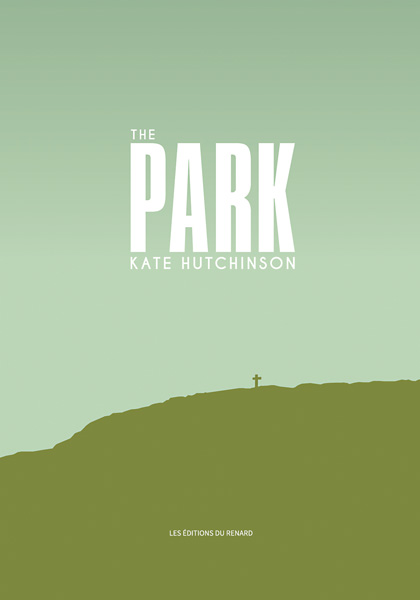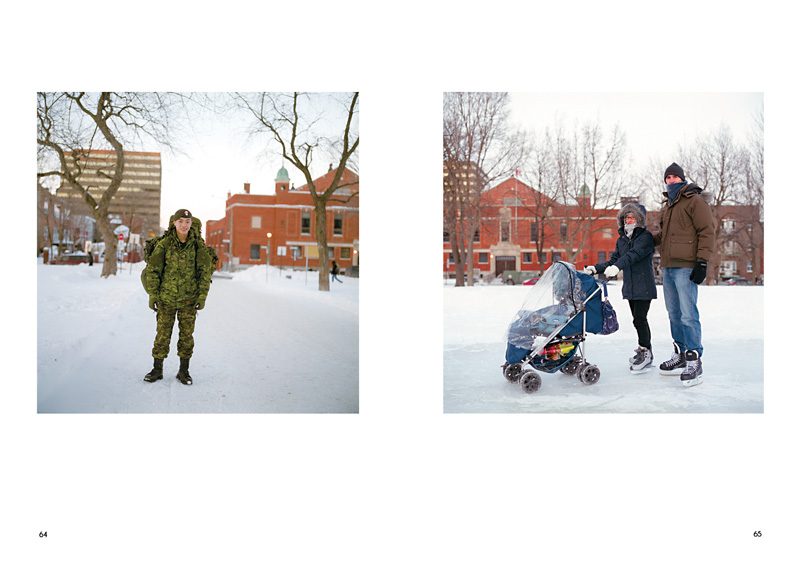The Park
Kate Hutchinson
Les Éditions du renard, Montréal, 2015, 140 pages, ill. colour
Postface by Cynthia Imogen Hammond
“PARK, a space of ground used for public or private recreation, differing from a garden in its spaciousness and the broad, simple, and natural character of its scenery, and from a ‘wood’ in the more scattered arrangement of its trees and greater expanse of its glades and consequently of its landscapes.” – Frederick Law Olmsted, “Park,” in The American Cyclopædia (1879 edition).
“I love feeling like you are among your neighbours when you are in the park; you are part of a community.”
— Kate Hutchinson
By James D. Campbell
Sometime in the early twenty-third century, a sealed copper box is found interred at the foot of the excavated cross on top of Montreal’s estimable Mount Royal. Once opened, archaeologists and sundry forensic experts find a fulsome sheaf of what seem to be vernacular images. Although interpretations vary as to the identities and occupations of the subjects, one thing is certain: they are all enduring portraits, all photographed in the park on Mount Royal, and they all resemble you and me.
Seriously, Kate Hutchinson, gifted street photographer and professor in Concordia University’s Department of Journalism, has just published a book of portraits of quintessential Montrealers, native and visitors alike, at play in two of the city’s most-frequented (and -cherished) green spaces – Jeanne-Mance Park and Mount Royal Park. The fruit of two years spent walking around the parks with camera in hand, the portrait series began formally in the spring of 2013.
By her own estimation, Hutchinson photographed hundreds of people of all ethnic persuasions and occupations, but fewer than one hundred images made the final cut. Her criterion for choosing her subjects was simply their intrinsic “interestingness.” They were not rehearsed or posed in any way, and her interaction with them was often quite brief. She confesses, however, to an obsession with light. When she witnesses beautiful light falling on prospective subjects, that is a real clincher.
She is no stranger to the park, having spent over thirteen years wandering within its precincts – she lives in the neighbourhood – but it was only after the birth of her daughter that she began visiting there in earnest, perhaps as a way of regaining a sense of community, of integrating herself back into the social world. She says, “I find that when people go to the park they are often open to talking to strangers. It seems to be a place where people feel at ease, almost as though the park were an extension of their private spaces.”
Hutchinson captures the magic of the park as an oasis of refuge, recreation, Socratic honesty – and the epitome of a private space made public. She began photographing, casually at first but then with increasing fervour, as the project took flight in her imagination, within the compass of her camera, and on the negative.
What distinguishes Hutchinson’s work from that of countless others working similar terrain? It is her humanity, her inclusiveness, and a quality of and capacity for empathy for which the park, urban crossroads sans pareil, is the perfect alembic and incubator.
She uses a Hasselblad 500 C/M with 80mm lens, a bulky apparatus that she handles with ease. Her film of choice is Fuji Pro 400H 120. The work is compositionally pristine and never overreaching, revealing a casual authority that comes from a lifelong familiarity with the medium.
Who does Hutchinson look to for inspiration? She confesses to a profound admiration for the work of photographer Alec Soth and the Helga paintings by American painter Andrew Wyeth. In terms of her Park series specifically, she cites the work of American photographer Alessandra Sanguinetti, whose The Adventures of Guille and Belinda and the Enigmatic Meaning of Their Dreams (2010) left a considerable impression upon her. Sanguinetti’s long-term photo essay documenting two child cousins on a rural farm south of Buenos Aires, Argentina, powerfully affected Hutchinson – and informed her optic. (In 1999, Sanguinetti began working on an extended series of photographs centring on the lives of two young cousins Guille and Belinda, whom she photographed for the better part of ten years with their full cooperation, documenting with remarkable sensitivity their passage from childhood to adulthood.)
Hutchinson is drawn to the endless variety of her subjects and, at a time when the immigration crisis has reached fever pitch in Europe and the controversy surrounding immigration has touched our own shores, her work stands like a sentinel as enduring as the Mount Royal cross, a luminous beacon on the side of the dispossessed and the culturally diverse. Her considerable powers of empathy, wed to a phenomenal acuity of vision, make these images unforgettable – and unforgettably human.
James D. Campbell is a writer and curator who writes frequently on photography and painting from his base in Montreal.


